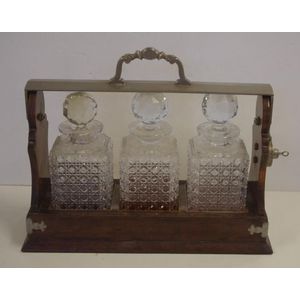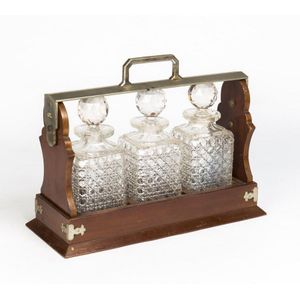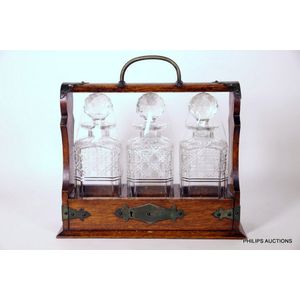Antique Oak Tantalus with Crystal Decanters
An antique oak tantalus with three cut crystal decanters, 19th century, the oak tantalus with Gothic brass trims enclosing the original matching square section decanters with canted edges and flat diamond cuts to the upper register, with facet cut stoppers, height 27.5 cm, length 34 cm, width 13 cm
You must be a subscriber, and be logged in to view price and dealer details.
Subscribe Now to view actual auction price for this item
When you subscribe, you have the option of setting the currency in which to display prices to $Au, $US, $NZ or Stg.
This item has been sold, and the description, image and price are for reference purposes only.
- Tantalus - A tantalus is a container for holding two or three glass or crystal bottles of alchoholic drinks. A tantalus may take various forms, the most common being made from silver, silver plate or wood with the three bottles in a circle or two bottles in line with a central handle. A larger version has three bottles in a line with two end supports and a horizontal top and handle. To prevent unauthorised access, some tantalus have a locking mecahnism that prevents the bottles and stoppers being removed from the bottles when secured.
A box tantalus, as the name implies is an elaborate wooden box made of a fancy timber such as coramandel, with divisions for the bottles and a lockable lid. Some of these type are designed for liquers and include the liquer glasses set into fitted holders. - Oak - Native to Europe and England, oak has been used for joinery, furniture and building since the beginning of the medieval civilisation. It is a pale yellow in colour when freshly cut and darkens with age to a mid brown colour.
Oak as a furniture timber was superceded by walnut in the 17th century, and in the 18th century by mahogany,
Semi-fossilised bog oak is black in colour, and is found in peat bogs where the trees have fallen and been preserved from decay by the bog. It is used for jewellery and small carved trinkets.
Pollard oak is taken from an oak that has been regularly pollarded, that is the upper branches have been removed at the top of the trunk, result that new branches would appear, and over time the top would become ball-like. . When harvested and sawn, the timber displays a continuous surface of knotty circles. The timber was scarce and expensive and was used in more expensive pieces of furniture in the Regency and Victorian periods. - Faceting - Faceting is a technique of removing material from a curved surface, to give a series of flat surfaces but retaining the profile of the original surface.
The technique is most commonly associated with diamond cutting where the various cuts used such as rose cut and brilliant cut, add life and sparkle to the stone, whilst at the same time removing as little of the stone as possible.
Faceting by grinding is also used to decorate glass. The stems of many drinking glasses are decorated by cutting a series of flat surfaces on a circular stem, and hollow vessels such as vases may have faceted surfaces.
In furniture faceting is often applied to legs of tables and chairs, where a circular baluster shaped section is flattened so as to form an octagonal section.
This item has been included into following indexes:
Visually similar items

Oak 3 decanter tantalus, with key, 35 cm wide, 33 cm high
Sold by
in
for
You can display prices in $Au, $US, $NZ or Stg.

Antique English 3 decanter tantalus by Betjemanns, London, 41.5 cm wide
Sold by
in
for
You can display prices in $Au, $US, $NZ or Stg.

Tantalus, beautifully Presented in oak case: Brandy, Gin, Whiskey
Sold by
in
for
You can display prices in $Au, $US, $NZ or Stg.

A Tantalus with 3 hobnail cut crystal decanters, late 19th early 20th century. 32 cm high, 41 cm wide
Sold by
in
for
You can display prices in $Au, $US, $NZ or Stg.
